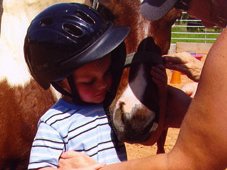Horses as Therapy

Therapy through horses can bring multiple benefits, allowing those who participate to discover new ways of dealing with their difficulties, and, in many cases, overcome or significantly reduce those problems.
And therapy through horses isn’t just for those with a physical or mental disability. A participant who has recently gone through a severe loss in their life, such as a major bereavement, can also benefit hugely.
How it Works
Having horse-based or equine therapy is not about learning to ride per se. Instead, patients take part in a wide range of activities allowing them to be involved with the animals. This might include riding, but also grooming or just walking with or leading the horses on a rein.
Adults and children of all ages have been found to benefit from equine-based therapy, both as individuals and in groups. Successful work has also been carried out with prison inmates.
The Horses
There are many organizations offering this therapy across the US, many of them non-profit making. And any breed can work in therapy, although stallions and competition horses are generally ruled out. Horses undergo rigorous safety assessments, and need a gentle, unstressed temperament to do this work.
Psychological Benefits
The sight, sound, touch and smell of horses alone has been found to lift a person’s mood and have an extremely calming effect. But horse therapy is also about helping participants to overcome their fears, and learn new skills while exploring their feelings in a safe environment, and developing an outlet for their anxieties.
Problem solving, communication, respect, compassion, personal responsibility and self-awareness can all be taught through equine therapy. At the same time, self-esteem and confidence can improve immeasurably thanks to this work.
Physical Benefits
Especially if the patient is actually in the saddle as part of their horse-based therapy, the physical benefits of horse-based therapy can be enormous, whatever the nature and extent of their difficulty.
Gently touching the animals and the movement of the body when riding releases oxytocin, also known as the ‘cuddle hormone’, which evokes feelings of contentment, reduces anxiety, and brings about feelings of calmness and security.
Finally, equine therapy has also been shown to improve circulation when a patient takes to the saddle.
Work with ADD/Autistic Kids
For children who are autistic or have ADD, or bipolar disorder, the reduced exposure to artificial noise, light and smells that go with being in the natural world are very beneficial and soothing.
Equally, therapy with horses has been found to stimulate areas of the brain known as learning receptors, which is no doubt why there is also evidence of expanded vocabulary and verbal and written communication skills as a result of the equine sessions.
Horse therapy has been found to be especially helpful in enabling these kids to express themselves and to concentrate. Because horses respond well to having a good leader, it’s also a great way for children to learn leadership skills.
With so much going for it, it’s no wonder that equine facilitated therapy is gaining so much momentum across the US for so many people of all ages, facing a huge variety of challenges in their lives.













